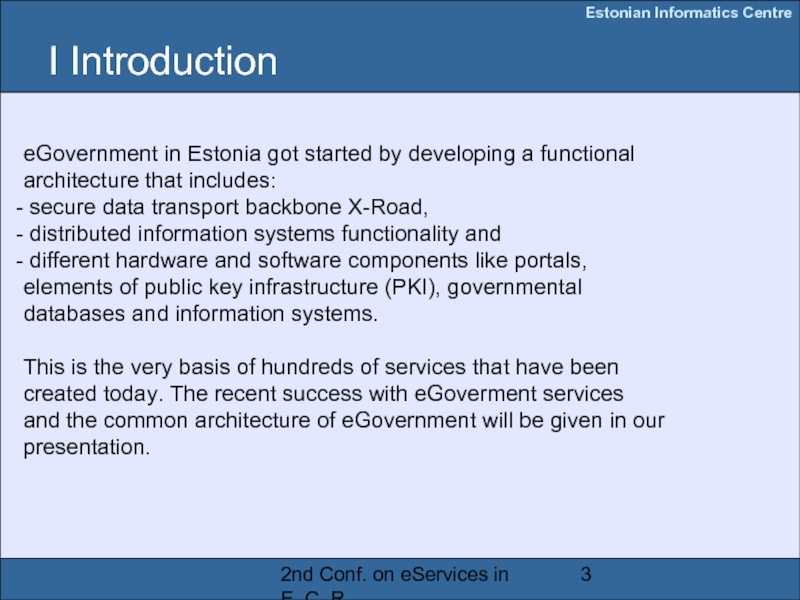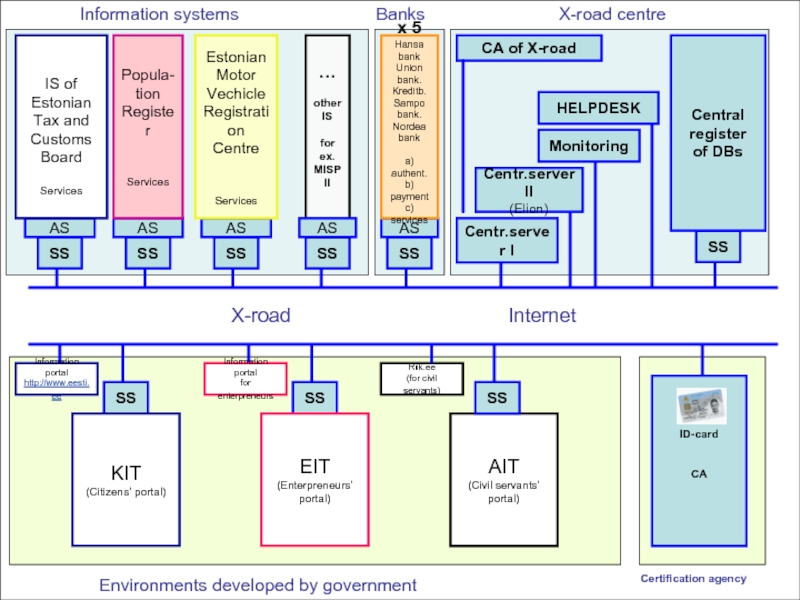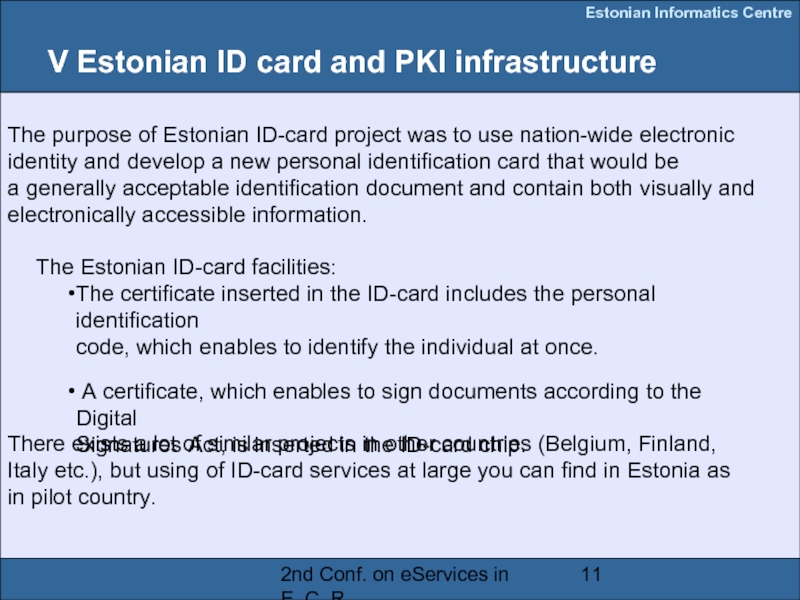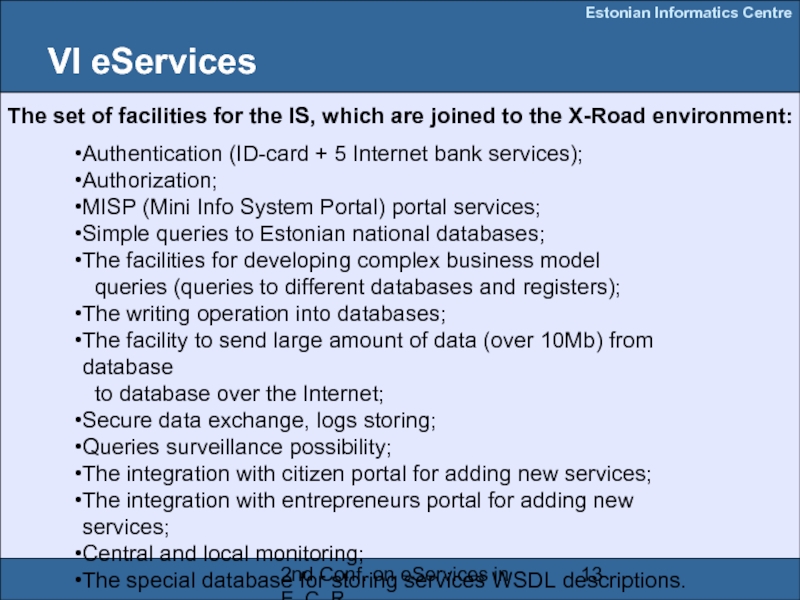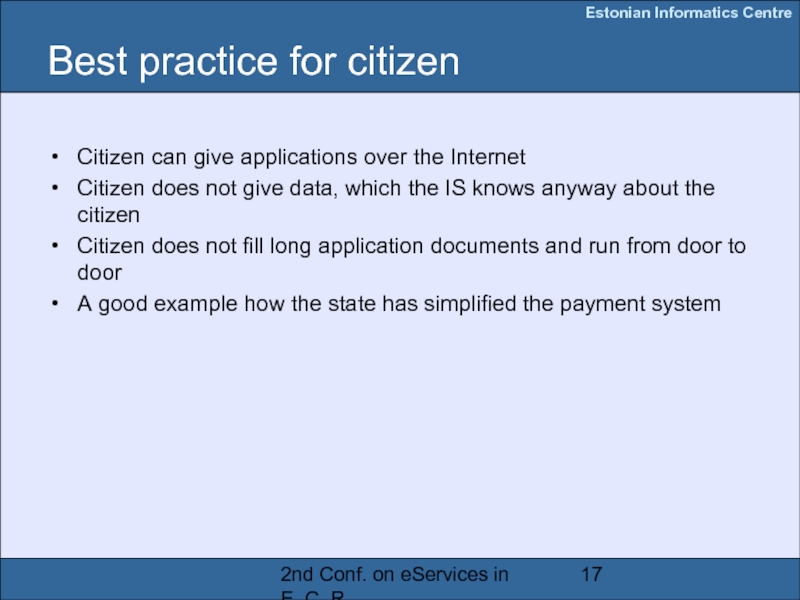Ahto Kalja
Tallinn Univ. of Technology, Ehitajate tee 5, 19086, Tallinn, Estonia/
Estonian Informatics Centre, Rävala 5, 15169 Tallinn, Estonia
ahto@cs.ioc.ee
- Главная
- Разное
- Дизайн
- Бизнес и предпринимательство
- Аналитика
- Образование
- Развлечения
- Красота и здоровье
- Финансы
- Государство
- Путешествия
- Спорт
- Недвижимость
- Армия
- Графика
- Культурология
- Еда и кулинария
- Лингвистика
- Английский язык
- Астрономия
- Алгебра
- Биология
- География
- Детские презентации
- Информатика
- История
- Литература
- Маркетинг
- Математика
- Медицина
- Менеджмент
- Музыка
- МХК
- Немецкий язык
- ОБЖ
- Обществознание
- Окружающий мир
- Педагогика
- Русский язык
- Технология
- Физика
- Философия
- Химия
- Шаблоны, картинки для презентаций
- Экология
- Экономика
- Юриспруденция
Estonian example of integration e-government services презентация
Содержание
- 1. Estonian example of integration e-government services
- 2. 2nd Conf. on eServices in E. C.
- 3. 2nd Conf. on eServices in E. C.
- 4. 2nd Conf. on eServices in E. C.
- 5. 2nd Conf. on eServices in E. C.
- 6. 2nd Conf. on eServices in E. C.
- 7. 2nd Conf. on eServices in E. C.
- 8. 2nd Conf. on eServices in E. C.
- 9. 2nd Conf. on eServices in E. C.
- 10. 2nd Conf. on eServices in E. C.
- 11. 2nd Conf. on eServices in E. C.
- 12. 2nd Conf. on eServices in E. C. R. Estonian ID card
- 13. 2nd Conf. on eServices in E. C.
- 14. 2nd Conf. on eServices in E. C.
- 15. 2nd Conf. on eServices in E. C.
- 16. 2nd Conf. on eServices in E. C. R. eServices ePolice eHealth eElections … Internet-banking
- 17. 2nd Conf. on eServices in E. C.
- 18. 2nd Conf. on eServices in E. C.
- 19. 2nd Conf. on eServices in E. C.
- 20. 2nd Conf. on eServices in E. C.
- 21. 2nd Conf. on eServices in E. C.
- 22. 2nd Conf. on eServices in E. C. R.
- 23. 2nd Conf. on eServices in E. C. R.
- 24. 2nd Conf. on eServices in E. C. R.
- 25. 2nd Conf. on eServices in E. C. R. Thank you!
Слайд 12nd Conf. on eServices in E. C. R.
Estonian example of integration
Слайд 22nd Conf. on eServices in E. C. R.
Content
I Introduction
II The general
III Results of Estonian eGovernment projects
IV Special citizens web portal with db-services
V Estonian ID card and PKI infrastructure
VI eServices
VII A new generation eService “Parental benefit” in Internet
VIII Statistics
IX Conclusions
Слайд 32nd Conf. on eServices in E. C. R.
I Introduction
eGovernment in Estonia
architecture that includes:
secure data transport backbone X-Road,
distributed information systems functionality and
different hardware and software components like portals,
elements of public key infrastructure (PKI), governmental
databases and information systems. This is the very basis of hundreds of services that have been
created today. The recent success with eGoverment services
and the common architecture of eGovernment will be given in our
presentation.
Слайд 42nd Conf. on eServices in E. C. R.
II The general architecture
The architecture of eGovernment was developed in the framework of the
X-Road project.
X-Road project was preliminarily initiated for interconnecting Estonian
governmental databases to the common data resource accessible over
the Internet.
After the successful start of sending database queries and answers over
the Internet, the X-Road environment was expanded to send all kinds of
XML-format electronic documents securely over the Internet.
At the same time the X-Road started to become a skeleton of all the
eGovernment services.
Слайд 52nd Conf. on eServices in E. C. R.
X-road
Internet
SS
AS
SS
SS
AS
SS
AS
SS
IS of
Estonian
Tax and
Customs
Board
Services
Popula-
tion
Register
Services
Estonian
Motor
Vechicle
Registration
Centre
Services
…
other IS
for ex.
MISP II
Information systems
X-road centre
KIT
(Citizens’ portal)
Information portal
http://www.eesti.ee
Riik.ee
(for civil servants)
CA of X-road
Centr.server I
Centr.server II
(Elion)
Monitoring
SS
Central
register
of DBs
HELPDESK
Environments developed by government
SS
AS
Banks
x 5
Hansa bank
Union bank.
Kreditb.
Sampo bank.
Nordea bank
a) authent.
b) payment
c) services
SS
EIT
(Enterpreneurs’ portal)
Information portal
for enterpreneurs
AIT
(Civil servants’ portal)
SS
ID-card
CA
Certification agency
AS
Слайд 62nd Conf. on eServices in E. C. R.
Databases
Data transport
X-road
Services
3-layers architecture I
Слайд 72nd Conf. on eServices in E. C. R.
Databases
Data traffic
X-road
Services
Oracle
Progres
MySQL
…
Traffic register
Population register
Passports
…
SOAP
XML RPC
LDAP
…
WSDL
UDDI
I layer
II layer
III layer
Technology
Components
Parential benefit
My vehicles
My penalties
…
Security server
Central server
MISP
Citizen portal
…
3-layers architecture II
Слайд 82nd Conf. on eServices in E. C. R.
III Results of Estonian
During the last 3-4 years we have finished different IT projects for implementing
eGovernment architecture in the public sector of Estonia. As the result of the
mentioned projects, the following service portals, environments and frameworks
are now available in Estonia:
Special citizens web portal with db-services. Portal has won an award
Finalist with Honourable Mentions of the eEurope awards for
eGovernment 2003. The portals eServices will step-by-step be added
to the citizen portal (KIT) in the nearest future;
Framework of the facilities for using Estonian ID-card (over 70% of
Estonian population has already an electronic ID-card) with PKI technology
for identification, authorization and digital signature operations;
Citizens, civil servants and entrepreneurs web portals with almost 700
different eServices from different Estonian central and local governments.
Later we will describe some of these environments projects more precisely.
Слайд 92nd Conf. on eServices in E. C. R.
IV Special citizens web
All services available through the citizen's portal have a common user
interface, which is not dependent on a database management system for
back office.
A standard authentication system for all citizens has been developed as well.
The set of standard services available include typical queries, such as:
"give me my data" from the population register;
"give me my data" from the motor vehicles register.
Слайд 102nd Conf. on eServices in E. C. R.
Citizen
CA of
citizens
Civil
servant
Portal
Authenti-
cation
MISP
Security
server
Security
server
Central
server
Internet
Security
server
Security
server
CA of
servers
IS of
organizat.
Adapter-
server
Data-
base
Users
Database
processors
SSL channels,
digitaly signed
encrypted messages
Central
server
Local
monitoring
Local
monitoring
Central
monitoring
Functional scheme
Слайд 112nd Conf. on eServices in E. C. R.
V Estonian ID card
The purpose of Estonian ID-card project was to use nation-wide electronic
identity and develop a new personal identification card that would be
a generally acceptable identification document and contain both visually and
electronically accessible information.
There exists a lot of similar projects in other countries (Belgium, Finland,
Italy etc.), but using of ID-card services at large you can find in Estonia as
in pilot country.
The Estonian ID-card facilities:
The certificate inserted in the ID-card includes the personal identification
code, which enables to identify the individual at once.
A certificate, which enables to sign documents according to the Digital
Signatures Act, is inserted in the ID-card chip.
Слайд 132nd Conf. on eServices in E. C. R.
VI eServices
The set of
Authentication (ID-card + 5 Internet bank services);
Authorization;
MISP (Mini Info System Portal) portal services;
Simple queries to Estonian national databases;
The facilities for developing complex business model
queries (queries to different databases and registers);
The writing operation into databases;
The facility to send large amount of data (over 10Mb) from database
to database over the Internet;
Secure data exchange, logs storing;
Queries surveillance possibility;
The integration with citizen portal for adding new services;
The integration with entrepreneurs portal for adding new services;
Central and local monitoring;
The special database for storing services WSDL descriptions.
Слайд 142nd Conf. on eServices in E. C. R.
VII Best practice
Parential benefit
5 information systems interact the data
Citizens’ portal
Register of Social Insurance Board (+MISP)
Population register
IS of Health Insurance Fund
IS of Tax and Customs Office
Слайд 152nd Conf. on eServices in E. C. R.
DBs
X-road
Users
Citizen
Civil servant
Parential benefit in
Citizens’
portal
MISP
Register of Social
Insurance Board
Population register
IS of Health
Insurance Fund
IS of Tax and
Customs Office
Слайд 172nd Conf. on eServices in E. C. R.
Best practice for citizen
Citizen
Citizen does not give data, which the IS knows anyway about the citizen
Citizen does not fill long application documents and run from door to door
A good example how the state has simplified the payment system
Слайд 182nd Conf. on eServices in E. C. R.
Best practice for civil
Civil servant is free from revising mountains of paper documents (7)
Civil servant is free from inputting the data from paper documents
Civil servant is free from checking data in different databases
Civil servant can start the process by inputting only the personal code of client
There does not exist any paper applications at all
Слайд 192nd Conf. on eServices in E. C. R.
VIII Statistics
At the moment
Organizations: Number of agreements – ~366
Databases/Service providers:
All service providers: 69
Security servers:
Number of agreements for SS: 80
Слайд 202nd Conf. on eServices in E. C. R.
Statistics
Services:
The number services from
The statistics of usage:
During the year 2003, the total number of X-road queries was: 590 000.
Number of queries made via the X-road in 2004: over 7.75 million
Daily record of queries in 2004: 118 000 queries per day
Number of queries made via the X-road in 2005: over 13.45 million
Слайд 212nd Conf. on eServices in E. C. R.
IX Conclusions
We are sure
and portals are making significant contributions to the process of moving
towards the information society. Our environment represents Estonian
and European best practice in the application and usage of new
technologies in order to provide eServices to citizens, to civil servants
and to entrepreneurs.


